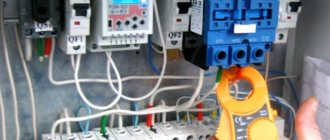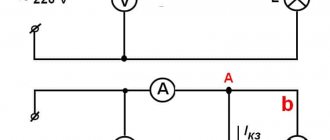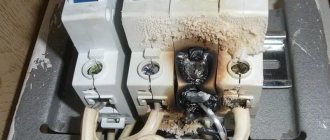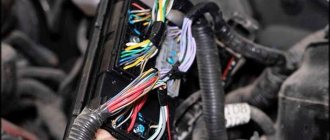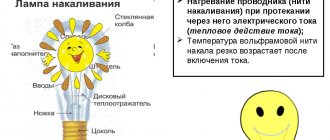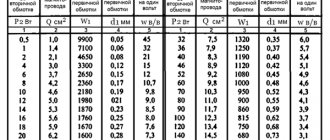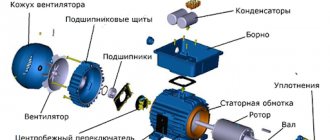Content
- 1 Definition
- 2 Short circuits in AC electrical installations 2.1 Types of short circuits in AC electrical installations 2.1.1 Symmetrical short circuits
- 2.1.2 Asymmetrical short circuits
Short circuit in electrical installation (short circuit)
- any accidental or intentional, not provided for by normal operating mode, electrical connection of various points (phases) of an electrical installation with each other or with the ground, in which the currents in the branches of the electrical installation adjacent to the place of its origin increase sharply, exceeding the maximum permissible continuous current.
Short circuit to ground in an electrical installation (ground fault)
- a short circuit in an electrical installation caused by the connection of any of its current-carrying elements to the ground. Short circuits can occur in AC and DC electrical installations.
Practical implementation of TZNP
Today, current protection that responds to the occurrence of a zero sequence can be implemented by microprocessor units and through relays. In most cases, outdated relays are widely replaced with newer versions of current protection. But, in addition to TZNP, remote, differential protection and other devices are configured for operation. Whose work is based on both symmetrical components and other network parameters.
In addition, in its classic design, TZNP does not have the ability to determine the location of damage. That is, it does not matter to her where the break occurred. Therefore, directional protection is used to determine the direction in which current flows towards ground. Such a system is built not only on currents, but also on voltage arising from the zero sequence. These values are supplied from voltage transformers connected in an open delta system.
Directional protection operating diagram
When there is a short circuit in the current protection redundancy zone, voltage is supplied to one of the windings of the power relay, and a zero-sequence current used for current protection is supplied to the second winding. Provided that the power vector is directed into the line, the power relay unblocks the operation of the current protection. Otherwise, when the power direction indicates that the fault has occurred in another section, the power relay will continue to block the current protection from tripping.
Today, the practical implementation of such protection is carried out using REL650 microprocessor units or EPZ-1636 relays. Each of which already includes current cut-off, distance protection, and a starting relay to restore power.
Zero sequence current is:
The sum of the instantaneous values of the currents of the three phases of a three-phase system The zero-sequence system differs significantly from the direct and reverse ones in that there is no phase shift. The zero current system essentially represents three single-phase currents, for which the three wires of the three-phase circuit represent the forward wire, and the return wire is the ground or the fourth (zero), through which the current returns.
Types of short circuits in AC electrical installations[edit]
Types of short circuits can be divided into two groups - symmetrical
and
asymmetrical
short circuits.
Symmetrical short circuits[edit]
Symmetrical short circuit
— Short circuit in an electrical installation, in which all its phases are under the same conditions.
Symmetrical short circuits include only three-phase short circuits.
Three-phase short circuit
— Short circuit between three phases in a three-phase electrical power system. Note: With a three-phase short circuit, the presence or absence of a ground fault does not affect the short circuit parameters.
Asymmetrical short circuits[edit]
Asymmetrical short circuit
— Short circuit in an electrical installation, in which one of its phases is in conditions different from the conditions of other phases.
Asymmetric short circuits include:
- Single-phase short circuit to ground
- short circuit to ground in a three-phase electrical power system with solidly or effectively grounded neutrals of the power elements, in which only one phase is connected to the ground.
Note: A single-phase ground fault in networks with an isolated or compensated neutral is not short.
- Two-phase short circuit
- a short circuit between two phases in a three-phase electrical power system. - Two-phase short circuit to ground
- short circuit to ground in a three-phase electrical power system with solidly or effectively grounded neutrals of power elements, in which two phases are connected to the ground. - Double short circuit to ground in an electrical installation
- short circuit to ground of two different phases in a three-phase electrical power system at different but electrically interconnected points.
Oil, Gas and Energy
Here are all the short circuits that happen in this life, and all the definitions.
1.
A short circuit in an electrical installation is
a circuit in which the currents in the branches of the electrical installation adjacent to the place of its occurrence increase sharply, exceeding the maximum permissible continuous current.
Notes:
· A short circuit is any accidental or intentional electrical connection of various points of an electrical installation to each other or to the ground, not provided for by the normal operating mode.
· This concept of the term should be distinguished from its other concept, not used in this standard, meaning an action leading to an electrical connection between different points, for example, closing contacts, closing a circuit.
2.
Short circuit to ground in an electrical installation
- a short circuit in an electrical installation caused by the connection of any of its elements to the ground.
3.
Short circuit to ground in an electrical installation
- a short circuit in an electrical installation, accompanied by contact of the short circuit point with the ground.
4.
Single-phase short circuit to earth
(single-phase short circuit) - a short circuit to earth in a three-phase electrical power system with solidly or effectively grounded neutrals of the power elements, in which only one phase is connected to the ground.
5.
Two-phase short circuit
- a short circuit between two phases in a three-phase electrical power system.
6.
Two-phase short circuit to earth
- a short circuit to earth in a three-phase electrical power system with solidly or effectively grounded neutrals of the power elements, in which two phases are connected to the ground.
7.
Two-phase short circuit to ground
- a two-phase short circuit in a three-phase electrical power system with ungrounded or resonantly grounded neutrals of power elements, accompanied by contact of the short circuit point with the ground.
8.
Double short circuit to ground in an electrical installation
- a combination of two single-phase short circuits to ground in different but electrically connected parts of the electrical installation.
9.
Three-phase short circuit -
a short circuit between three phases in a three-phase electrical power system.
10.
Three-phase short circuit to earth
- a short circuit to earth in a three-phase electrical power system with solidly or effectively grounded neutrals of the power elements, in which three phases are connected to the ground.
11.
Three-phase short circuit to ground
- a three-phase short circuit in a three-phase electrical power system with ungrounded or resonantly grounded neutrals of power elements, accompanied by contact of the short circuit point with the ground.
12.
Short circuit between branches of the winding of one phase
(Inter-branch short circuit).
13.
Short circuit between coils or winding sections of one phase
(Intercoil or intersectional short circuit).
14.
Interturn short circuit -
a short circuit between different turns of one coil or winding section of an electrical machine, transformer or electrical apparatus.
15.
Repeated short circuit
- a short circuit in an electrical installation when the electrical switching device of the damaged circuit is automatically restarted.
16.
Variable short circuit
- a short circuit in an electrical installation with a transition from one type of short circuit to another.
17.
Persistent short circuit -
a short circuit in an electrical installation, the conditions for the occurrence of which are maintained during the dead pause of the electrical switching device.
18.
Unstable short circuit -
a short circuit in an electrical installation, the conditions for the occurrence of which self-liquidate during a dead pause of the electrical switching device.
19.
Symmetrical short circuit
is a short circuit in an electrical installation in which all its phases are under the same conditions.
20.
Asymmetrical short circuit
- a short circuit in an electrical installation in which one of its phases is in conditions different from the conditions of other phases.
21.
Remote short circuit
- a short circuit in an electrical installation in which the amplitude of the periodic component of the current of a given energy source at the initial and arbitrary moments of time is almost the same.
22.
A close short circuit
is a short circuit in an electrical installation in which the amplitude of the periodic component of the current of a given energy source at the initial and at arbitrary moments of time is significantly different.
23.
Unremote short circuit
- a close short circuit on an overhead electrical line connected to the switch, located from it at a distance of several hundred meters to several kilometers, at which the shutdown conditions become significantly more difficult.
24.
Short circuit current in an electrical installation
- the current that occurs during a short circuit in an electrical installation.
25.
Current at the point of short circuit
- the total current of all branches of the electrical installation converging at the point of the short circuit.
26.
The free component of the short circuit current in an electrical installation
is the component of the short circuit current in an electrical installation, determined only by the initial conditions of the short circuit, the structure of the electrical network and the parameters of its elements.
27.
The forced component of the short circuit current in an electrical installation
is a component of the short circuit current in an electrical installation, equal to the difference between the short circuit current and its free components.
28.
The aperiodic component of the short circuit current in an electrical installation
is the free component of the short circuit current in an electrical installation, changing over time without changing sign
29.
The periodic component of the short circuit current of the operating frequency in an electrical installation (
Periodic component of the short circuit current) is the component of the short circuit current in the electrical installation, varying according to a periodic law with the operating frequency.
30.
Periodic component of short circuit current of non-operating frequency in an electrical installation
.
31.
Instantaneous value of short circuit current in an electrical installation
- the value of short circuit current in an electrical installation at the considered moment in time.
Note. Similarly, the instantaneous values of voltage and EMF during a short circuit in an electrical installation are determined.
32.
The effective value of the short circuit current in an electrical installation
is the root mean square value of the short circuit current in an electrical installation for a period of operating frequency, the middle of which is the considered moment in time.
33.
The effective value of the periodic component of the short-circuit current of the operating frequency in an electrical installation
(The effective value of the periodic component of the short-circuit current) is the root mean square value of the periodic component of the short-circuit current of the operating frequency in the electrical installation for a period, the middle of which is the considered moment in time.
34.
The initial effective value of the periodic component of the short-circuit current of the operating frequency in the electrical installation (
Initial value of the periodic component of the short-circuit current) is a conditional value equal to the double amplitude of the periodic component of the short-circuit current of the operating frequency in the electrical installation at the initial time, reduced by a factor.
Note. The double amplitude of the periodic component of the short-circuit current at the initial or any other moment in time is understood as a conditional value determined from the curve of the change in short-circuit current over time as the difference between the ordinates of the upper and lower envelopes of this curve at the corresponding moment in time.
35.
Initial value of the aperiodic component of the short circuit current in an electrical installation.
36.
Steady-state short-circuit current in an electrical installation
is the value of the short-circuit current in an electrical installation after the end of the transient process, characterized by the attenuation of all free components of this current and the cessation of current changes from the influence of automatic control devices for excitation of energy sources.
37.
Impact coefficient of short-circuit current
(Impact coefficient) - the ratio of the impact short-circuit current to the amplitude of the periodic component of the short-circuit current of the operating frequency at the initial time.
38.
Switchable short circuit current
is the short circuit current of an electrical target at the moment the arc extinguishing contacts of its electrical switching device begin to diverge.
39.
The effective value of the periodic component of the switched-off short-circuit current
is a conventional value equal to the double amplitude of the periodic component of the short-circuit current at the moment the arc-extinguishing contacts of the switching electrical device begin to diverge, reduced by a factor.
40.
Aperiodic component of the interrupted short circuit current
- the value of the aperiodic component of the short circuit current at the moment the arc extinguishing contacts of the electrical switching device begin to diverge.
41.
The amplitude value of the switched short circuit current
is a conditional value equal to the arithmetic sum of the effective value of the periodic component of the switched short circuit current, increased by a factor, and the aperiodic component of the switched short circuit current.
42.
Voltage at the short circuit
- the voltage of any phase or pole of the electrical installation at the short circuit.
43.
Residual voltage during a short circuit
is the voltage of any phase or pole of an electrical installation at the considered point of the network, remote from the location of the short circuit.
44.
Symmetrical components of an asymmetrical three-phase short-circuit current system -
three symmetrical three-phase short-circuit current systems of the operating frequency of direct, reverse and zero sequences, into which this asymmetrical three-phase short-circuit current system can be decomposed.
Note: The symmetrical components of an asymmetrical three-phase voltage system during a short circuit are determined in the same way.
45.
Direct sequence short circuit current
is one of the currents of a symmetrical three-phase system of direct sequence short circuit currents.
Note. The positive sequence voltage during a short circuit is determined in the same way.
46.
Negative sequence short circuit current
is one of the currents of a symmetrical three-phase system of reverse phase short circuit currents.
Note. The negative sequence voltage during a short circuit is determined in the same way.
47.
Zero sequence short circuit current
is one of the currents of a symmetrical unbalanced three-phase system of zero phase sequence short circuit currents.
Note. The zero sequence voltage during a short circuit is determined in the same way.
48.
Expected short circuit current
is the short circuit current that would be in the electrical circuit of the electrical installation in the absence of the action of the current-limiting switching electrical device installed in it.
49.
Passed short-circuit current
is the largest instantaneous value of short-circuit current in the electrical circuit of an electrical installation, taking into account the action of the current-limiting switching electrical device.
50.
Through short-circuit current of an electrical switching device
(Through short-circuit current) - the current passing through a switched-on electrical switching device during an external short circuit.
51.
Content of the aperiodic component of the interrupted short-circuit current
- The ratio of the aperiodic component of the interrupted short-circuit current to the multiplied value of the periodic component of the interrupted short-circuit current at the same point in time.
52.
The harmonic composition of short circuit current
is a set of sinusoidal currents of various frequencies into which the short circuit current can be decomposed.
53.
The phase of the occurrence of a short circuit in an electrical installation is
the voltage phase of the electrical installation at the moment the short circuit occurs, expressed in electrical degrees.
54.
The free transient component of the short circuit current in an electrical installation
is the periodic component of the short circuit current in an electrical installation, caused by the relatively slowly decaying currents of the rotor circuits of a synchronous machine.
55.
The transient component of the short circuit current in an electrical installation
(Transient short circuit current) is the periodic component of the short circuit current in an electrical installation, equal to the sum of the forced and free transient components of the short circuit current.
56.
The free supertransient component of the short circuit current in an electrical installation
is a periodic component of the short circuit current in an electrical installation, caused by the relatively quickly decaying currents of the rotor circuits of a synchronous machine and manifesting itself in the initial period of the short circuit.
57.
The subtransient component of the short circuit current in an electrical installation
(Supratransient short circuit current) is a periodic component of the short circuit current in an electrical installation, equal to the sum of the transient and free subtransient components of the short circuit current.
58.
Short circuit power
is a conditional value equal to the product of the three-phase short circuit current multiplied by the rated voltage of the corresponding electrical network.
59.
Longitudinal asymmetry in an electrical installation
is the asymmetry of a three-phase electrical installation caused by an asymmetrical three-phase element connected in series to its circuit.
Note. The asymmetry of a three-phase electrical installation is the inequality of the values of the parameters of the elements of its phases
60.
Transverse asymmetry in an electrical installation
is an asymmetry of a three-phase electrical installation caused by a short circuit of one or two phases to ground or two phases to each other.
61.
Single asymmetry in an electrical installation
is a longitudinal or transverse asymmetry that occurs at one point in the electrical installation.
62.
Complex asymmetry in an electrical installation
- asymmetry of a three-phase electrical installation, which is a combination of longitudinal and transverse asymmetries.
63.
A special phase of an electrical installation
is the phase of a three-phase electrical installation, which, when longitudinal or transverse asymmetry occurs, finds itself in conditions different from the conditions for the other two phases.
64.
Short circuit current distribution coefficient
- the ratio of the forward, negative and zero sequence current of the circuit in question to the electrical installation to the current of the corresponding sequence at the short circuit.
65.
Boundary conditions for asymmetry in an electrical installation
(Boundary conditions) - characteristic relationships for currents and voltage at the point of damage for various types of asymmetry in an electrical installation.
66.
The critical time of the aperiodic component of the short circuit current in an electrical installation
is the time during which the voltage at the terminals of a synchronous machine decreases as a result of a short circuit and reaches the nominal value under the action of the automatic excitation regulator.
67.
The time constant of the aperiodic component of the short circuit current in an electrical installation
is an electromagnetic time constant that characterizes the rate of attenuation of the aperiodic component of the short circuit current.
68.
The design conditions for a short circuit of an electrical installation element
are the most severe, but quite probable conditions in which the electrical installation element in question may find itself in the event of various types of short circuits.
69.
The calculated type of short circuit in an electrical installation
is the type of short circuit in which the calculated short circuit conditions for the electrical installation element in question occur.
70.
Design point of a short circuit in an electrical installation
- a point in an electrical installation at which, in the event of a short circuit, the design conditions of a short circuit take place for the element of the electrical installation under consideration.
71.
The estimated duration of a short circuit in an electrical installation
is the duration of a short circuit, which is calculated for the element of the electrical installation under consideration when determining the impact of short circuit currents on it.
72.
Probabilistic characteristics of a short circuit in an electrical installation
- a set of characteristics that describe the probabilistic nature of various parameters and short circuit conditions.
73.
The thermal effect of short circuit current in an electrical installation
is a change in the temperature of electrical installation elements under the influence of short circuit current.
74.
The electrodynamic effect of short circuit current in an electrical installation
is the mechanical action of electrodynamic forces caused by the short circuit current on the elements of the electrical installation.
75.
Joule integral
is a conventional value characterizing the thermal effect of short circuit current on the electrical installation element under consideration, numerically equal to the integral of the square of the short circuit current over time, ranging from the initial moment of the short circuit to the moment of its shutdown.
76.
Metallic circuit
(not acceptable:
dead circuit
) - a circuit in which the resistance at the place of its origin, i.e. The transition resistance is very small and can be neglected.
77.
Arc fault
- a fault in which an electric arc is formed at the point of its origin.
78.
Ground fault
– a fault caused by a connection to the ground.
79.
Single-phase ground fault
(not permissible:
simple circuit
) - a ground fault of one of the phases of an electrical installation in a three-phase system with ungrounded or resonantly grounded neutrals of power elements.
80.
Double earth fault
- a combination of two single-phase earth faults in different but electrically connected parts of an electrical installation.
Changes in current during a short circuit
During the short circuit, the current undergoes various changes. At the very beginning it increases, then it fades to a certain value, and then the automatic excitation regulator brings it to a stable value.
The time period required to change the parameters of the short circuit current - TKZ - is called the transient process. At the end of this period and until the moment when the short circuit is turned off, a stable emergency mode is observed. The magnitude of the current at various periods of time is necessary when choosing settings for protective equipment, checking the dynamic and thermal stability of electrical equipment.
Calculation of short-circuit currents for three-phase networks
In order to determine the three-phase short circuit current in the corresponding networks, it is necessary to take into account the specifics of the occurrence and development of this process. First of all, this is the inductance that occurs in a closed conductor, due to which the current of a three-phase short circuit does not change instantly, but increases gradually in accordance with certain laws.
The accuracy of the calculations performed depends primarily on the calculations of the basic quantities inserted into the formula. For this purpose, additional formulas or special software are used that perform complex computational operations in a very short time.
If calculations in three-phase networks are performed manually, in such cases the necessary results of the short-circuit current flow, the formula given below allows you to determine with fairly accurate indicators:
- Is = Uc/(√3*Hres) = Uc /(√3*(Xsyst + Hvn)), in which Hvn is the resistance between the busbars and the short-circuit point, Xsist is the resistance in the entire system relative to the voltage source buses, Uc is the voltage on tires in this system.
Short circuits and their classification. Consequences of short circuit using real examples
Good afternoon, dear readers of the Electrician's Notes website.
I have long wanted to write an article about short circuits. But somehow they didn’t get around to it.
Today I decided because the latest events that occurred at the distribution substation of our enterprise influenced me.
Earlier in articles we said that damage in electrical installations causes short circuits, or short circuits for short.
A short circuit is one of the most severe and dangerous types of damage.
You will ask why? Read below.
What is a short circuit?
Wikipedia answers this question that a short circuit is:
Read the definition.
Now let's take a closer look at what happens to the parameters of the electrical installation at the time of a short circuit.
When a short circuit occurs, the voltage on the power source, or more correctly called the EMF, is short-circuited through a small (small value) resistance of cable and overhead lines, windings of transformers and generators. Hence the name "short circuit".
In a “short-circuited” circuit, a very large current appears, which is called short-circuit current.
Classification of short circuits
Let's consider the classification of short circuits.
Short circuits are divided by the number of closed phases:
- three-phase short circuits
- two-phase short circuits
- single-phase short circuits
Short circuits are divided by circuit:
Short circuits are divided by the number of shorted points in the network:
- at one point
- at two points
- at several points (more than two)
Example
Let's look at an example.
Let's assume that our consumer is powered from a substation through an overhead power line (OHL). The supply line is transit, so the consumer is powered by a tap from the overhead line at point “O”.
The dotted line number 2 shows the voltage level along the entire overhead line before a short circuit occurs.
The figure shows that the voltage at any point in the electrical network is equal to the difference between the EMF of the power source and the voltage drop in the electrical circuit to the point we need.
For example, the voltage at point “O” can be calculated using the formula:
Uо = E - I*Zo, where
- E - EMF of the power source, in our case the generator
- Zo is the total resistance of the overhead lines from the power source to point “O” (consists of active and reactive resistance)
- I is the current flowing through the overhead line at a given time.
Similarly, we can calculate the voltage at any point in our overhead lines.
Let's assume that for some reason there is a short circuit on the overhead line, but outside our tap. Let's call this short circuit point the letter "K".
Break of one linear (phase) wire in a three-wire three-phase circuit
Asymmetrical mode of operation of a three-wire three-phase circuit
If the phase resistances are unequal z
A≠
z
B≠
z
C phase currents will also be unequal to each other
I
A≠
I
B≠
I
C.
The voltages on the phases are distributed in direct proportion to the phase resistances (the greater the resistance, the greater the voltage drop across it).
Point O can take any position in triangle ABC (Fig. 3.9),
U
A≠
U
B≠
U
C.i.e.
“phase imbalance” occurs.
Rice. 3.9. Topographic vector diagram for asymmetrical mode
loads when connecting consumers into a star
If one linear wire breaks, for example, wire A (Fig. 3.10, a), the circuit turns into a single-phase one, with receivers connected in series. If Z
B=
Z
C, then
U
B=
U
C= 0.5
U
BC (Fig. 3.10, b).
Point O moves down and divides vector U
BC into two equal parts.
If you measure the voltage between the receiver neutral and line wire A, it will be equal to 1.5 U
F.
Rice. 3.10. Scheme ( a
) and topographic vector diagram when a line wire breaks (
b
)
Your opinion is important to us! Was the published material useful? Yes | No
Source
